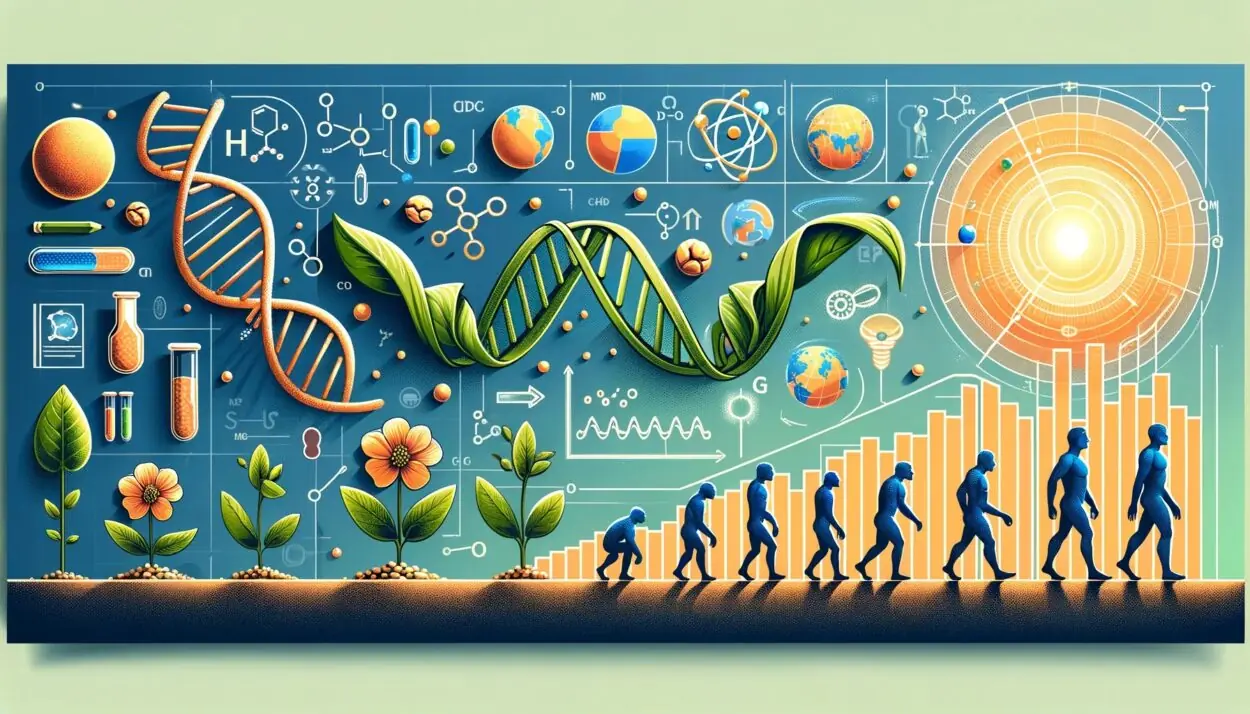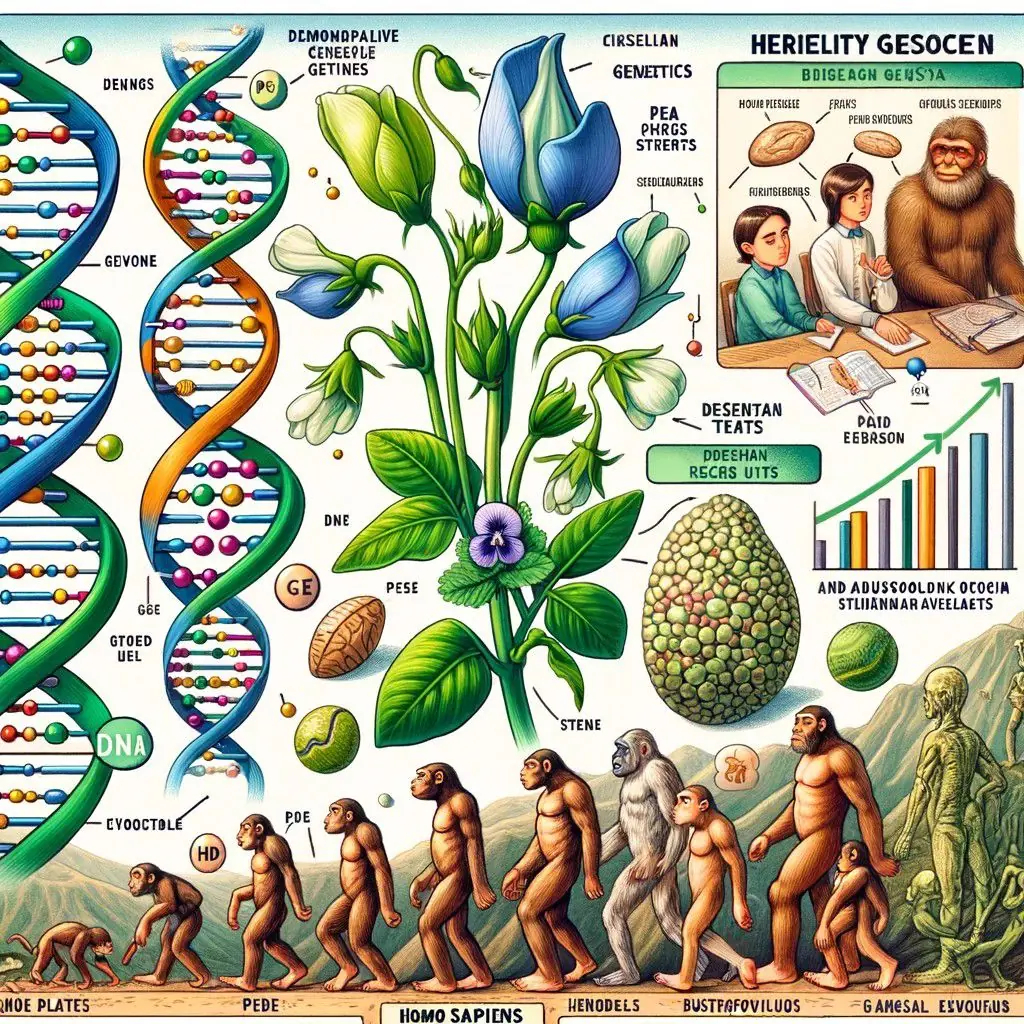
Exploring the Mysteries of Heredity and Evolution: A Detailed Guide for Class 10 Students

Heredity and Evolution: Exploring the Foundations of Genetics for Class 10 Students
Introduction to Heredity and Evolution
Heredity and evolution are fundamental concepts in biology, providing a window into the past and a map for the future of species. Heredity explains how traits and characteristics are passed down from one generation to the next, while evolution sheds light on how species change over time.
Understanding Heredity
Genes and Genetics
- Genes: The basic unit of heredity, genes are segments of DNA that code for specific traits.
- Alleles: Variants of a gene that lead to different expressions of a trait.
- Dominant and Recessive Traits: How certain traits are expressed in offspring.
Laws of Inheritance
- Mendel’s Laws: Gregor Mendel’s principles of segregation and independent assortment explain how traits are inherited.
Genetic Disorders
- Study of genetic disorders like hemophilia and sickle cell anemia.
Evolution: The Process of Change
Theories of Evolution
- Charles Darwin’s Theory of Natural Selection: Explains how traits that enhance survival are more likely to be passed on.
- Speciation: The formation of new species through evolutionary processes.
Evidence of Evolution
- Fossils: Remnants of ancient organisms provide clues about past life.
- Comparative Anatomy: Similar structures in different species indicate common ancestry.
- Embryology: Study of embryos shows developmental similarities.
Human Evolution
- Early Human Ancestors: From Australopithecus to Homo sapiens.
- Migration and Spread: How early humans migrated and adapted.
Genetic Engineering and Its Implications
- DNA Technology: Advances in manipulating genetic material.
- Ethical Considerations: The implications of genetic modification.
Conclusion
Heredity and evolution are not just historical processes; they are active and ongoing, shaping the living world around us.
Frequently Asked Questions
- What is the difference between heredity and genetics?
- How does natural selection contribute to evolution?
- What are some examples of genetic disorders?
Glossary
- Genotype: The genetic makeup of an organism.
- Phenotype: The physical expression of genes.
- Mutation: A change in the DNA sequence.
Activities for Better Understanding
- Genetic Trait Survey: Collect data on genetic traits among classmates.
- Fossil Study: Research and present on a specific fossil.

The accumulation of variation during reproduction plays a crucial role in heredity, driving the diversity we see within and between species. Here’s how it works:
Mechanisms of Variation:
- Sexual reproduction:
- Meiosis: During gamete formation, chromosomes randomly mix their genetic material through crossing over and independent assortment. This creates a vast array of possible gametes from each parent, leading to immense diversity in offspring.
- Fertilization: Combining gametes from two individuals further increases variation, as their unique genetic makeups blend.
- Mutations: Spontaneous changes in DNA sequence can occur during replication or be induced by environmental factors like radiation. These mutations can create new traits or alter existing ones, contributing to variation.
Consequences of Variation:
- Individual differences: No two individuals, even siblings, are genetically identical due to the above mechanisms. This variation manifests in physical appearance, behavior, and susceptibility to diseases.
- Raw material for evolution: The accumulated variation over generations acts as the fuel for natural selection. Individuals with traits better suited to their environment survive and reproduce, passing on their advantageous genes. This gradual process leads to the adaptation and evolution of populations.
- Genetic continuity: While offspring show variations, they also inherit essential traits from their parents, ensuring continuation of species characteristics.
Examples:
- Human eye color and height exhibit wide variation due to a combination of multiple genes and their interactions.
- Antibiotic resistance in bacteria arises from mutations that allow them to survive treatment.
- The beak shapes of Darwin’s finches on the Galapagos Islands adapted to different food sources through natural selection, highlighting the role of accumulated variation in evolution.
Understanding the accumulation of variation during reproduction is vital in explaining the diversity of life, its adaptability to changing environments, and the fascinating process of evolution.
- Q: What is heredity?
- A: Heredity is the process by which traits and characteristics are passed from parents to their offspring through genes.
- Q: Who is known as the father of genetics and why?
- A: Gregor Mendel is known as the father of genetics because of his pioneering work in studying the inheritance of traits in pea plants.
- Q: What is the difference between genotype and phenotype?
- A: Genotype refers to the genetic makeup of an organism, while phenotype is the observable characteristics or traits of that organism.
- Q: Define natural selection.
- A: Natural selection is a process where organisms with traits better suited to their environment are more likely to survive and reproduce, passing on those advantageous traits to their offspring.
- Q: What evidence supports the theory of evolution?
- A: Evidence supporting evolution includes fossil records, comparative anatomy, genetic similarities, and embryological development.
- Q: What are mutations and their role in evolution?
- A: Mutations are changes in the DNA sequence. They are a source of genetic variation and can lead to new traits that may be beneficial for an organism’s survival, contributing to evolution.
- Q: What is the significance of the human evolution timeline?
- A: The human evolution timeline shows the progression and evolutionary development of the human species, from early ancestors like Australopithecus to modern humans, Homo sapiens.
- Q: Explain the concept of genetic disorders.
- A: Genetic disorders are diseases or conditions caused by abnormalities in the genome. They can be inherited or result from mutations in the DNA.
- Q: What is the principle of independent assortment in genetics?
- A: Mendel’s principle of independent assortment states that the alleles of two (or more) different genes get sorted into gametes independently of each other, contributing to genetic diversity.
- Q: How has genetic engineering impacted our understanding of heredity and evolution?
- A: Genetic engineering has allowed scientists to directly manipulate genes, providing deeper insights into gene functions, hereditary diseases, and evolutionary relationships among species.